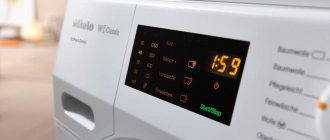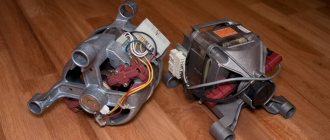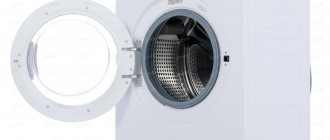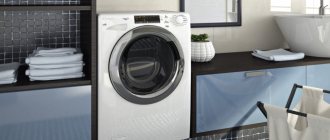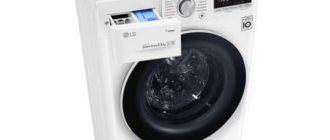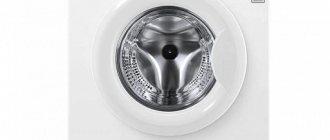Every housewife has to deal with laundry. Today, household appliances – an automatic washing machine (AWM) – help with this difficult task. When choosing a device, many parameters are taken into account: drum capacity, energy efficiency, size.
Weight is a factor that goes unnoticed by the buyer. The weight of an automatic washing machine, how significant this parameter is, and how heavy models differ from light ones - this will be discussed in the article.
What determines the weight of a washing machine?
Washing machine drum
Factors affecting the weight of the unit:
- volume of the tank;
- type of instalation.
Some models may be heavier than others because their body is made of heavier metal.
Also, the weight of the unit depends on the availability of additional options that require the appropriate parts. For example, the “drying” function.
Washing machines are equipped with counterweights of different materials - these are parts that help balance the drum. The weight of the “weighting agent” depends on the manufacturer.
How to choose the right machine?
Before purchasing household appliances for washing clothes, you need to decide on the place where it will be located. The choice of Kandy washing machine model is influenced by the following factors.
- Parameters of the space specifically allocated for the device. It is necessary to measure the width and depth (in the case of a washbasin above the machine, the height) of the space allocated for the device, and then subtract 1 cm from each parameter. This is necessary to ensure that there are gaps between household appliances and various surfaces. They are required to compensate for the vibrations that the machine produces.
- Localization of communication outputs. A certain space must be left behind the device to accommodate both the inlet and drain hoses. On average, this margin is 5 cm.
- Doorway width. Before you buy a large multifunctional unit, you should make sure that it will fit through the door.
- Dimensions of a furniture set or other devices that are adjacent to Kandy. If you plan to install built-in equipment, you need to accurately calculate all the characteristics.
Important! The main condition for a successful purchase is the correct location for the washing machine, taking into account its size, design features and additional clearances for vibrations.
Why you need to know about weight
Narrow washing machine
There are a number of situations in which the mass of equipment is as important a parameter as its performance, size or functionality:
- The housing is located on a high floor, and the elevator has limited capacity. Knowing the weight of the device, it is easy to plan delivery and installation;
- when moving frequently, it is much easier to transport a light washing machine than a heavy one;
- a narrow automatic washing machine is selected. Narrow models are easier to place in cramped living conditions, but due to the small support area, washing can get out of control. Equipment can vibrate so much and “start dancing” that it damages communications and wires. It’s good if the model has an “auto-balancing” function that controls balance by changing the engine speed;
- I often have to wash heavy, bulky laundry. Winter jackets, duvets and other rather large items can throw even a resistant washing machine off balance. If such washing is a frequent occurrence, then it is better to look for a heavier model;
- select a free-standing model with a spacious drum. Built-in machines themselves are stable, as they are installed in a furniture set, adhering to the walls on both sides. free-standing models lose in this regard, therefore, if the drum capacity is more than 7 kg, take into account the weight of the equipment.
In short, mild SMA is more likely to start waltzing around the room. Heavy ones are more stable.
Power letters
To make it easier to indicate energy efficiency, a breakdown into energy efficiency classes was invented. They are designated by letters of the Latin alphabet from A to D, where A is the highest indicator, D is the lowest. As technology improved, becoming more and more economical, pluses began to be added to the Class A marking in order to more accurately reflect the power consumption parameter. What does the breakdown by kW look like according to classes?
- A+++. By far the most economical class. Units with this marking spend 0.13 kW of electricity per 1 kg of laundry in 1 hour.
- A++. In 1 hour, 1 kg of cotton consumes 0.14-0.15 kW.
- A+. The maximum cost for the same parameters is 0.17 kilowatts per hour.
- A. When washing 1 kg of laundry, the machine consumes up to 0.19 kilowatts per hour.
- Power consumption reaches 0.23 kilowatts per hour per 1 kg of cotton.
- The machine “eats” 0.27 kW of energy per hour.
- The lowest efficient consumption class, when 0.31 kilowatts are consumed per kg of cotton per hour.
Knowing the energy efficiency class of the unit, you can easily calculate the power consumption per cycle. To do this, the power indicator is multiplied by the number of kg of laundry and the duration of the program in hours. For example, a machine of the most efficient class A+++ will spend about 0.65 kW for washing 5 kg of laundry for an hour.
Obviously, any calculations are approximate, since in everyday life washing machines are almost never washed in so-called ideal conditions, that is, corresponding to the conditions of measurements in production.
Note! The decoding of energy efficiency for semi-automatic washing machines is different, since the maximum power is graded differently.
How much does a washing machine weigh
There is no exact and unambiguous answer, since this parameter depends on many factors: what the body is made of, the capacity of the drum, dimensions, additional options. Average values are available.
Standard technique
Washing machine under the sink
The weight of most automatic washing machines is 30-100 kg. This figure is influenced by: technology class, functionality and built-in equipment.
Products weighing up to 50 kg are miniature devices that can easily be built under the sink or into a kitchen niche.
Next come models with a more substantial weight - up to 70 kg. Heavyweights, which have high spin speeds, can weigh as much as 100 kg.
The exact weight of the washing machine is indicated in the model data sheet. The average is from 50 to 70 kg.
Weight of the most popular models
Candy GVW 264DC.
Weight of SMA from leading manufacturers:
- Daewoo DWF-760P. The lightest top-loading model, weighing only 30 kg. Dimensions of the equipment – 52.5 x 85.8 x 53.5 cm. Drum capacity – 5.5 kg. Functionality: water level control, display, electronic control, 6 washing programs. Spin speed – 740 rpm. The disadvantage of this model is high water consumption. One cycle requires 130 liters;
- Galatec TL S-01L. Weight – 45 kg. Dimensions – 60 x 100 cm. Capacity of the drum with vertical loading – 10 kg. Spin speed – 1000 rpm. Among the functions: protection against children, leaks, delayed start up to 48 hours;
- Hansa AWS610DH. Weight – 50 kg. Type – horizontal. Dimensions – 60 x 47 x 85 cm. Drum volume – 6 kg. Spin speed – 1000 rpm. “On board” 8 washing modes. Functions: auto-cleaning system, leak protection, foam control, child protection. Control – electronic, there is an LED display;
- LG F-1096ND Weight – 60 kg. The advantage of this model is its removable cover, which allows it to be built into a headset. Dimensions – 60 x 44 x 85 cm. Loading – 6 kg. Spin speed – 1000 rpm. Control – electronic, with digital display. Number of modes – 13;
- Candy GVW 264DC. The weight of this frontal model is 70 kg. Case dimensions – 60 x 44 x 75 cm. Electronic control, protected against breakdowns and child intervention. Drum rotation speed during spinning is 1200 rpm. 12 modes. The advantage of the model is the Shiatsu drum, which carefully washes things even of different colors, and at the same time;
- Electrolux EWF 1497 HDW. Weight – 80 kg. Dimensions – 60 x 60 x 85 cm. Drum capacity – 9 kg. Spin speed – 1400 rpm. There are 12 programs for washing, including “jeans”, steam treatment and additional rinse. Protected from leaks. Legs can be adjusted in height;
- Miele WDB 020 W1 Classic. Heavyweight – 90 kg. The drum holds 7 kg of laundry. Dimensions – 60 x 64 x 85 cm. Drum rotation speed during spinning – 1400 rpm. Belongs to energy efficiency class A++. Number of programs – 12. Features: touch display, drum with a honeycomb structure “Soft Steam Drum”, “CapDosing” - convenient capsules (the equipment automatically calculates when and how much detergent to add).
Top-loading appliances are usually heavier, despite their more compact dimensions. This is provided by the manufacturer so that the washing machine does not sway too much during the spin cycle.
How is power determined?
The power consumption of washing units is calculated at the production stage. There is a whole algorithm for this:
- The new model is loaded with cotton linen by weight up to the maximum load volume;
- the temperature is set to 60 degrees;
- the unit is connected to a special device that reads the number of kW expended, and the cycle is started;
- The identified indicators are divided by the weight of the laundry and the duration of the program. The result is the power consumed by the machine per 1 kg of laundry per hour.
Important! As washing parameters vary, power consumption also changes.
Accordingly, if you put synthetic materials in the drum instead of cotton, fill the drum only halfway and set the express program rather than the standard one, the energy consumption parameters will change. If you try to identify some kind of pattern from all of the above, you will find that the final number of kW spent during washing is influenced by the following factors:
- type of washing machine (semi-automatic models “eat” much more than automatic models under identical washing conditions);
- type of fabric. Synthetic, blended materials, as well as wool products differ from cotton in weight and structure. This also affects power costs;
- selected mode. The lower the temperature and the shorter the wash, the less the heating element and motor work, therefore, the less electricity is consumed per cycle;
- loading volume. The units, the intensity of which is directly related to the weight of the laundry in the drum, also consume energy; accordingly, this parameter affects the power no less than the others.
Despite the fact that power consumption is a very variable parameter, the overall picture can be assessed with 100% confidence. After all, all units are tested in production using a single algorithm. Accordingly, if under certain conditions one unit consumes less than another, then this will be the case for any washing parameters.
Let's weigh the equipment
Classic Candy washing machines weigh between 50-63 kg. The weight of the device plays an important role when transporting the purchased goods requires the help of transport companies and other intermediary structures. The more household appliances weigh, the more expensive their delivery will cost the buyer. In addition, you may additionally need the help of loaders to lift the machine to the desired floor.
Oddly enough, the weight of a device does not always depend on its height, length and other external characteristics. However, the mass is directly dependent on the heaviness of the tank and counterweight blocks. The smaller the device, the heavier the counterweights should be so that the “washing machine” does not vibrate too much. For this reason, the weight of standard machines usually does not differ from the same parameter for small-sized ones. The more the device weighs, the more stable it is, the vibrations have a smaller amplitude, and the washing machine does not “jump” during the spin cycle.
Interesting:
- Rating of Kandy washing machines
- Which is better: Candy or LG washing machine?
- Furniture for the washing machine in the bathroom
- Rating of economy class washing machines
- Dimensions of the Indesit washing machine
- Dimensions of the washing machine - dimensions: height, width,...
Reader comments
- Share your opinion - leave a comment
